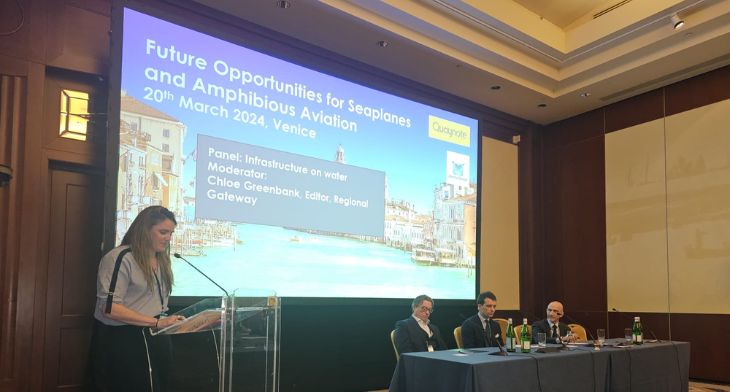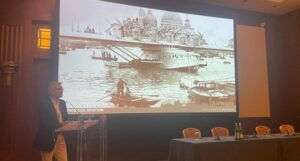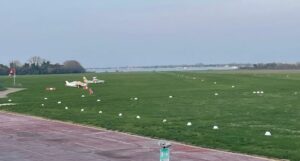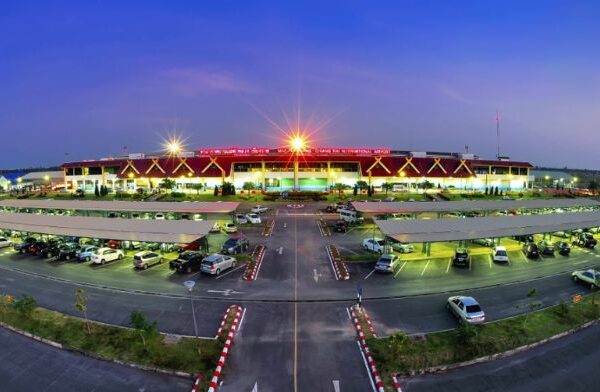


The mere mention of Venice and canals, gondolas, countless bridges and the buzz of water taxis immediately spring to mind. The “floating city” is an iconic location renowned for its reliance on the crisscrossing waterways that underpin the city’s transportation network. More a destination for a boating rather than a burgeoning aviation sector, you might think.
Think again. Stretched out across numerous small islands on a marshy lagoon along the Adriatic Sea in northeastern Italy, Venice also boasts a fascinating history in the seaplane sector. The first commercial seaplane services in Italy launched in 1926, with flights operating between Turin and Trieste – including stopovers in Venice.


“This is where the sector started,” he added, as he explained that the city had the first school and department for seaplanes in Italy and hosted the prestigious seaplane race, The Schneider Trophy, in 1927.
Back in the 1920s the seaplane sector was a flourishing sector and not just in Italy. “They flew everywhere and were the epitome of luxury travel,” Pinucci said, describing these seaplanes as halfway between an aircraft and a yacht, with spacious interiors that more closely resembled a cruise ship than the inside of the commercial passenger aircraft we know today.
So what caused the demise of this once booming sector, and why does seaplane aviation once again make sense today?
Pinucci is clear. “We are covered by 71 per cent water. We also have 1 million miles of coastline, 4.2 million square kilometres of lakes and more than three million miles of rivers. We can use that water.”
A burgeoning industry
The use cases for seaplanes and amphibious aviation are vast. “Whether it’s for recreational and training flights, leisure trips or firefighting, humanitarian and special missions, amphibious aircraft are versatile and accessible for remote areas, requiring minimal infrastructure other than natural water surfaces or existing airports,” said Pinucci.
More than 10 OEMs attended the inaugural amphibious aviation event in Venice, alongside operators, financiers and infrastructure specialists to discuss the lay of the land (or sea) for amphibious aviation, the existing operations and the challenges that lie ahead in the renaissance of a sector that has long been overlooked.
One of the big discussion points throughout the day concerned what is needed on the ground (or water) to support seaplanes and amphibious aircraft.
According to Peter Manice, co-founder of Tailwind Air, which provides scheduled seaplane services between New York and Boston among other routes: “Amphibious aircraft open up huge potential in North America for that short-haul (100 to 300 mile) connectivity. And if you look at island destinations such as the Maldives where there’s a lack of infrastructure, then seaplanes makes sense.”
He was joined by James Labouchere, Director Warrior (Aero-Marine), who pointed out that the world’s populations tend to congregate in coastal locations.
“The majority of people take their holidays by the sea, which opens up huge potential for developed markets as well as developing markets,” he said. He also noted that certain locations, such as Indonesia, which has a volcanic island range with a rocky, mountainous landscape, means that building airfields adjacent to the coast is not feasible from a logistical or cost perspective.
Mohan Chunduri, co-founder and COO, Mallard Enterprises, suggested that it is important to “talk about creating new routes from existing regional airports, which aren’t used sufficiently, so there is capacity there”.
Dennis Scott from Ocean Aircraft agreed. He said: “One of the big advantages for amphibious aviation is that there isn’t a requirement to build expensive tarmac runways or new infrastructure, so the sector is more sustainable by default.”
Eric Lithun, CEO and co-founder of Elfly, which is planning to bring its “no emissions” hybrid-electric seaplane Noemi to market in 2026, also plans to introduce a fleet of docking barges that can be used as floating infrastructure, with electric charging capabilities for amphibious aircraft.
“The beauty of this floating infrastructure is that it can be relocated as required,” he said.
However, panellists throughout the day were united in noting that the lack of cohesion between states when it comes to regulating these aircraft and where they can and cannot take off and land remains a major challenge.
Infrastructural requirements


“We’re working with the local authorities, including the Italian Civil Aviation Authority (ENAC) and the Magistrato alle Acque (Venice Water Authority), to understand the requirements and plan to establish a “water” runway over the lagoon to facilitate seaplane activities.
“The investment isn’t in the ground infrastructure, as the airport’s existing tarmac runway and terminal runs alongside the lagoon. It’s about establishing and understanding the necessary regulations for safe, secure operations on the water.”
Fabio Sciacca, founder of OneAviation and Sales Director at FlightSafety International, agreed. “Safety-minded risk analysis is key to these operations,” he said. “Understanding the end-to-end journey is a huge factor, so we need to be able to simulate take-off and landing requirements, the process of onboarding and disembarking passengers, servicing and storing aircraft overnight and accommodating other activities on the water. Training has a major role to play here, for which simulation is key in understanding how these operations will all work.”
He echoed Zamprogno’s call for wider collaboration across the sector and the need to engage with all the relevant players including operators and air traffic controllers, the coast guard, local authorities and environmental bodies in ensuring safe, efficient operations.


He said: “They might take off from water, but then need to land at an international airport. So we have to factor in what the passenger processing and security process will look like and ensure there is a common set of regulations. We need to remain flexible with the infrastructure as different use cases will have different infrastructural demands. And when it comes to electric propulsion, there is still plenty of uncertainty. Everything still has to implemented in terms of certification and charging requirements, so we’re at the very early stages of understanding what is required from the ground infrastructure.”
The big focus for the time being, he reiterated, has to be the “push for cohesion with regulations on a European level. This is an industry with huge potential that will create jobs and investment. It’s beneficial for the wider community and economy so governments need to get behind this sector.”
This collaborative push was echoed throughout the day. George Alavinov, CEO and Founder of Jekta, a start-up developing the PHA-ZE 100 regional amphibious aircraft, revealed that when he was seeking investment from a large venture capital company he was asked why he was the only one in this space.
“We’re not the only one, but this shows how difficult it is to revive this market,” he said. “I am happy there are more and more players in the market. Yes, we are competitors, but the market is big and we need to push together for its revival.”
MOVING to the future
As the day drew to a close, it was a message from Pinucci earlier in the day that summed up the importance of the event and the possibilities of amphibious aviation. “Cum Petere” he told delegates.
Explaining that the latin phrase means “to strive together,” he concluded that stakeholders across the sector must work alongside each other to fulfil the shared ambition of reviving the sector.
With that, he announced his collaboration with Nicelli Airport and Gayo Aviation’s Gisle Dueland to launch the Centre for Mobility and Viable Ecosystems (MOVE).
The networking platform is dedicated to reshaping the future of aviation by fostering a collaborative network where businesses and operators are united in their pursuit of pioneering sustainable and innovative aviation and tourism with seaplanes and amphibious aviation playing an integral role.






